Welcome to FISH FOOD TIMES
Oct. 2024 issue No.250

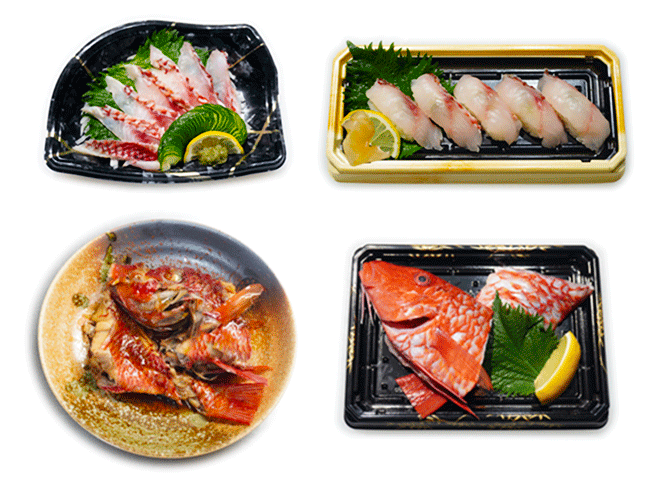
Whitesaddle goatfish
Fish retail store also sell this fish as Ojisan (old man).
In early May of this year, the fish section of a supermarket in Kumamoto Prefecture held its weekly event, "Goto Direct Market," as shown in the image below. The author purchased one fish called Ojisan (old man) from Goto, Nagasaki Prefecture, among the fish on display at the event. This fish section is one of the companies I currently supervise, and it has been 11 years since I started supervising the fishery department. On the day of the fisheries training session, I bought this fish at a slightly lower price and cooked it at home the next day.
This Goto direct delivery market project must have been going on for almost 10 years already, and the fish is actually brought in from Goto in Nagasaki prefecture, and it is an annual event that is held every Wednesday and Thursday. This provides support so that sales do not decline on weekdays. Various kinds of fish delivered from the fishing port of Goto are mainly sold as round fish in the naked sales corner. Even if all the round fish cannot be sold there, they are disassembled to be actively used as ingredients for sashimi and sushi, so there is no particular burden in terms of procurement, and it is one of the factors that increases the appeal of this fish counter.
By the way, although I cannot disclose the specific name of this store, the seafood department's sales accounted for 18.2% of the store's total sales in August 2024, which is almost the same level as the meat department's sales. In addition, while the fish department serves as the store's signature store in terms of sales, it has also maintained a very high level of profit over a long period of time, making a high contribution to the store.
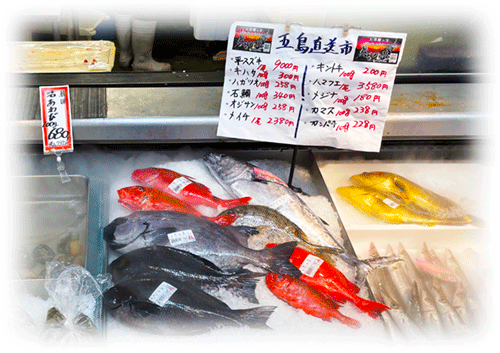
As shown in the image above, the product name was displayed as "ojisan" (old man) in the counter where they were sold naked, and the author myself thought that the fish shown in the image below was an "ojisan" (old man), so I purchased it.
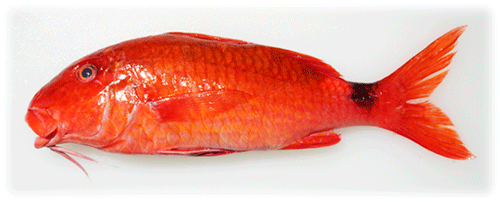
I thought so because this fish had a characteristic beard on its lower jaw. However, I later discovered that this fish was not an "ojisan" (old man) but a Whitesaddle goatfish, a fish that resembles the "ojisan" (old man) of the Goatfish family in the Perciformes.
The official Japanese name "ojisan" (old man) is shown below.
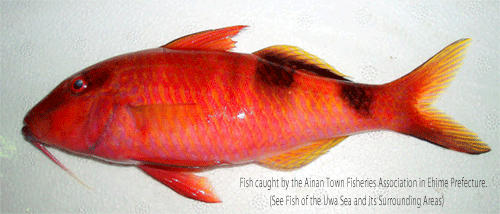
The "ojisan" (old man) is a fish of the Parupeneus genus of the Goatfish family, just like the Whitesaddle goatfish, and as you can see from the comparison, their appearances are very similar. For this reason, these fish are actually sold under the name "ojisan" (old man) in any fish market, so the name "ojisan" (old man) is also common in fish retailers across the country. And, to complicate matters, there is also the fish shown in the image below.
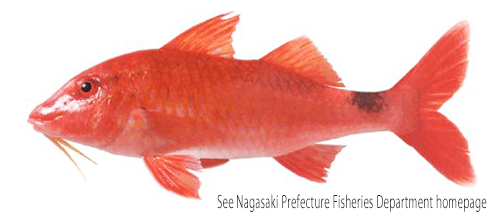
The fish in the image above is called Blackspot goatfish, but at the fish market and in fish retail stores it is called "ojisan" (old man). The Japanese name for the Blackspot goatfish is Okinahimeji, the Manybar goatfish is Ojisan, and the Whitesaddle goatfish is Hoyraihimeji. All of the English names are goatfish names, but the characteristic of the beard is likened to a goat.
Now, can you readers immediately tell the difference between the Whitesaddle goatfish in the first image and the Blackspot goatfish in the third? The image of the Blackspot goatfish is from the Nagasaki Prefectural Fisheries Department website, so it seems that the dorsal, pelvic and anal fins were forcibly spread apart in the photograph. If this fish was placed next to the Whitesaddle goatfish without the fins being forcibly spread apart, would it be possible to tell the difference between the two? I don't have that confidence.
The difference between the Blackspot goatfish and the Whitesaddle goatfish is that the black markings near the tail fin of the Whitesaddle goatfish extend slightly below the lateral line, while the markings of the Blackspot goatfish do not extend beyond the lateral line. Also, the chin whiskers of the Blackspot goatfish are whitish, which is why it is called okina (old man) himeji.
The beard is a major characteristic of fish in the Goatfish family, and about 17 species have been identified, including 10 species in the genus Parupeneus, which includes the three species mentioned above. This beard-like organ is officially called a barbel, and it has nerve bundles running through it, and around these nerves are the sensory organs, the taste buds. While higher vertebrates such as humans have taste buds in their mouths, fish of the Goatfish family have taste buds in their beards, through which they can judge the quality of food and identify fellow fish. This is an important sensor that is indispensable for the survival of fish of the Goatfish family.
My camera is broken
The season for Whitesaddle goatfish is from late spring to early summer, and I purchased this Whitesaddle goatfish on May 9th of this year. However, some readers may be wondering why I am featuring fish that I caught in season in May in an article for the October issue. The truth is that the LCD monitor of the camera I regularly use for photography broke.
Normally, the author uses a 35mm full-frame mirrorless single-lens camera set up at a height of about 2m overlooking the cutting board to take pictures of the process of cooking fish with a knife. A 28-70mm zoom lens is attached to this, and the time lapse function on the camera software is activated to automatically take photos at intervals of about 10 to 15 seconds.
When preparing fish on a chopping board, the camera lens is over 2m high, so you need to use a low stepladder to adjust the angle of view to the correct position. However, it is very difficult to look through the small viewfinder window from a high position, so I usually adjust the lens angle while looking at a flexible LCD monitor with an adjustable angle.
However, when I took the camera outside in early September, the LCD monitor stopped displaying any images. At that time, I took the picture while looking through the viewfinder, and I realized once again that while taking pictures while looking through the viewfinder is useful when it's a beautiful sunny day outside and it's too bright to see the LCD monitor easily, the LCD monitor is far easier to use at other times.
I have plans to take this camera out for nearly a week in late October, and I need it to be useful for taking photos, so I made sure to get it repaired as soon as possible and get it back to me as quickly as possible. The person in charge at the store who repaired my camera told me that it would take a month for the camera to be repaired and returned to me. For this reason, I decided to write the October issue by choosing fish from the images I had taken and saved on my computer.
A fish of the Parupeneus genus of the Goatfish family's old men is said to be delicious even when it is out of season, so I would like to take this as a consolation and write about Whitesaddle goatfish below.
Cooking Whitesaddle Goatfish
The scales of the Whitesaddle goatfish are relatively large and not particularly tightly attached to the skin. For this reason, in order to avoid scales flying in all sorts of directions that can occur when using a scale removal tool, it is convenient to remove the scales using a method of scale removal that I have arbitrarily named the "thumb diving method."
This is a very handy method for removing the scales of parrot fish, wrasse, and other members of the Labridae family. In particular, with parrotfish, the scales tend to stick together strangely when using a scale remover, making it difficult to remove the scales smoothly, but by using this thumb diving method, the scale removal process is surprisingly smooth.
The Whitesaddle goatfish belongs to the family Mullidae, not the Scaridae or Labridae, but the author intuitively felt that the thumb-diving method was the best way to remove the scales when he touched this fish, and he was right. It is unclear whether the thumb-diving method is suitable for other fish in the family Mullidae, but at least for the Whitesaddle goatfish, the thumb diving method is the appropriate method.
| Whitesaddle goatfish's scale removal using the thumb diving method |
|---|
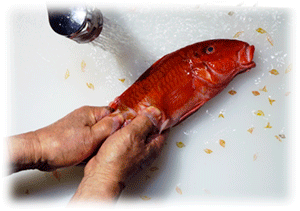 |
| 1,Insert the thumbs of both hands under the scales on the caudal peduncle near the tail fin and push them toward the head. |
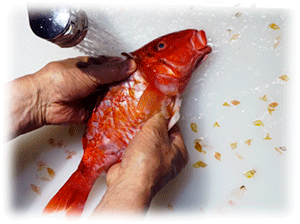 |
| 2,While running water over the fish, slide your thumb under the scales from the tail peduncle to the head, removing all the scales on the lower body. |
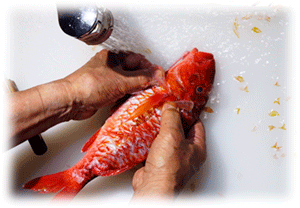 |
| 3,Remove all the scales from the upper body in the same way using your thumbs. |
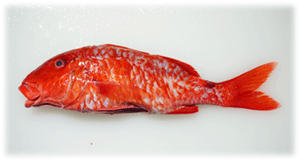 |
| Whitesaddle goatfish with the scales removed using the thumb diving method. |
I assumed that I would use one Whitesaddle goatfish to make a product, and decided to make one sashimi, one sushi, and one fillet. First of all, it was a fillet, but since it was relatively small in size, I decided to make a figure fillet using the head as well.
| Whitesaddle goatfish figure fillet work process | |
|---|---|
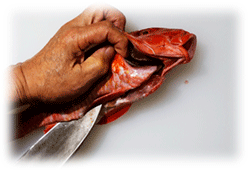 |
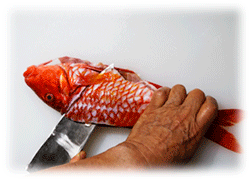 |
| 1,After removing the scales, cut open the abdomen of the fish. | 6,Cut from near the tail fin towards the head and separate the lower body. |
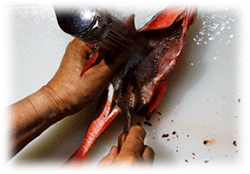 |
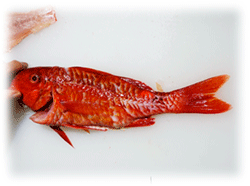 |
| 2,While running water over the fish, remove the gills and internal organs. | 7,Don't cut the head in half, just turn it over. |
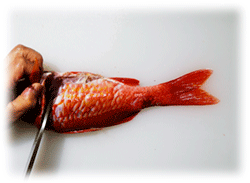 |
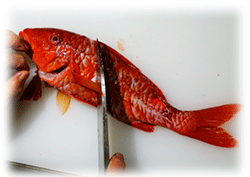 |
| 3,Wipe off any moisture from the fish body, and cut in between the head and body on the lower body side, until just before the backbone. | 8,Cut the half body with bones in half diagonally. |
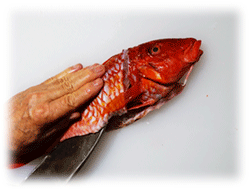 |
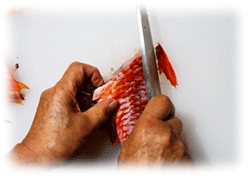 |
| 4,With the head still attached, cut open the lower body from the anal fin towards the backbone. | 9,Cut off the dorsal fin and anal fin. |
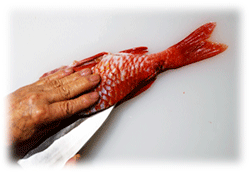 |
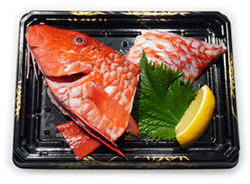 |
| 5,Cut open the edge of the dorsal fin on the lower side down to the backbone. | The whole whitesaddle goatfish fillet is complete. |
Next, I decided to make the Whitesaddle goatfish figure fillets into boiled fish.
| Whitesaddle goatfish figure fillet boiled fish work process |
|---|
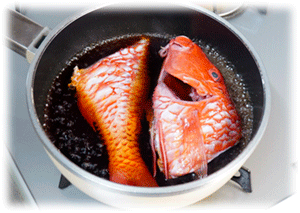 |
| 1,Bring the broth to a boil in a deep frying pan and add the fillets. |
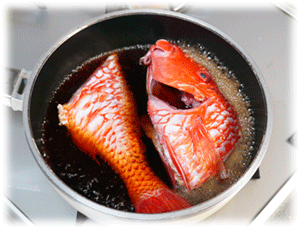 |
| 2,To prevent the thick half of the upper body of the head from being undercooked, pour the broth over the fillets several times using a ladle while simmering. |
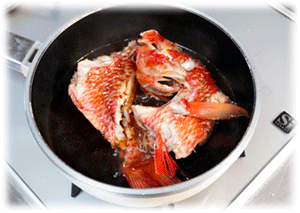 |
| 3,The head is thick and large, so it's hard to get flavor from it, but by pouring the broth over and over again, I was able to cook it deliciously to the edge. |
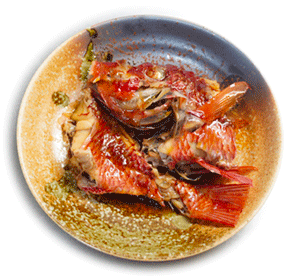 |
| Whitesaddle goatfish figure fillet boiled complete. |
Boiled Whitesaddle goatfish is a very delicious fish with moderately soft and white flesh and no unpleasant taste. I felt that this fish was one of the best fish for boiled fish dishes.
Whitesaddle goatfish sashimi and sushi
Next up is sashimi and sushi.
| Whitesaddle goatfish seared sashimi and seared sushi production process | |
|---|---|
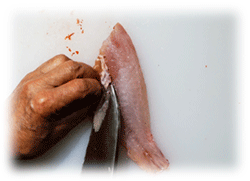 |
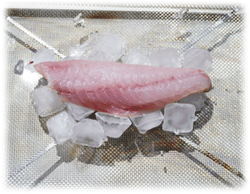 |
| 1,Remove the abdominal bone from the lower body. | 5,To cool the surface of the seared skin, chill it with crushed ice. |
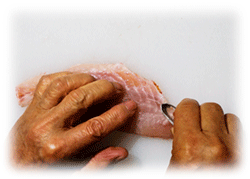 |
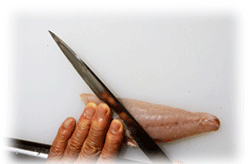 |
| 2,Pull out all the chiai bones using a boning tool. | 6,Place the fish with the seared skin facing down, turn your body to your left, and prepare it as sogitsukuri sashimi. |
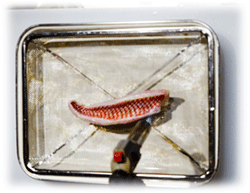 |
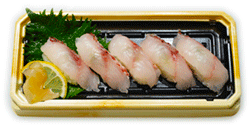 |
| 3,The skin of the lower body is seared with a burner. | 7,Five pieces cut from the head side with a sogitsukuri were used as ingredients for seared nigiri sushi. |
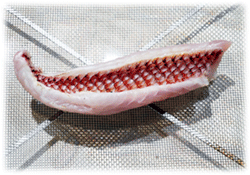 |
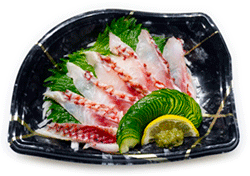 |
| 4,A state in which the half body is seared with a burner. | 8,Five slices of sushidane were secured from the half body, and the remaining part was used to make seared sogitsukuri sashimi. |
Whitesaddle goatfish is delicious both as sashimi and as sushi. I seared the skin, but for fish with a lot of subcutaneous fat, such as blackthroat seaperch, the skin is likely to peel off when cutting with a yanagiba knife, even if it is seared, and you may not be able to fully enjoy the goodness of the searing. However, in the case of whitesaddle goatfish, the subcutaneous fat is not too much, so the skin did not peel off when I cut it with a yanagiba knife, and it remained firmly attached to the meat.
In addition, even after searing, the red color of the skin remained, and when eaten as sashimi or sushi, the seared aroma added to the deliciousness, and together with the gorgeous appearance of the finished product, I felt that this was a fish that was well suited to searing.
Whitesaddle goatfish is an auspicious fish
I don't know much about Whitesaddle goatfish other than what I have written so far. After all, it is not a fish that I have ever been familiar with, as up until this point I had only had knowledge of this fish, lumping it all together under the name "ojisan" (old man).
It was only through this opportunity that I learned the name of the fish, "Whitesaddle goatfish," for the first time, so it is taboo to act like I know everything. Even so, it may seem odd to add this to the list of things I don't know, but I couldn't help but wonder about the name "hourai" in the Japanese name for Whitesaddle goatfish, "houraihimeji." So, I did a little research on why hourai is used, so if you have time, please continue reading the following articles.
The word "hourai" is written in kanji as "蓬莱", but even when I heard the word "hourai", I was embarrassed to say that my knowledge was limited to only being able to imagine meat buns and manju buns.
Horai seems to refer to the immortal realm where immortals live, which appears in ancient Chinese mythology. A long time ago, the ancient Chinese idea of divine immortals was introduced to Japan, and the influence of divine immortal ideas such as immortality can be seen in the Urashima Legend and the Tale of the Bamboo Cutter.
The immortal realm is thought to be an island at the edge of the ocean, and is said to exist either on or under the sea. From this, it seems that Ryugu exists within it, and is connected to the Ryugu legend that appears in Urashima Taro and UmisachihikoYamasahihiko.
In fact, it was a truly strange coincidence that in early September, the author had just visited a shrine that holds the legend of the Ryugu legend.
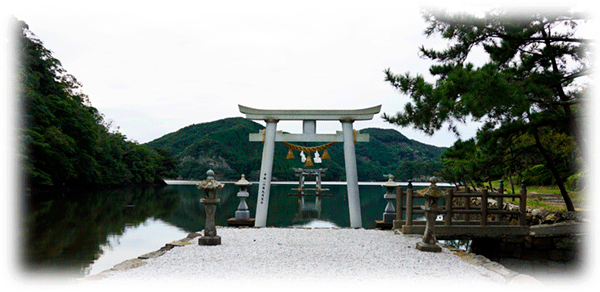
The shrine in question is Watatsumi Shrine, pictured above. It is located in Toyotama Town, Tsushima City, Nagasaki Prefecture, and five torii gates line up in a straight line from the main hall toward the sea. Two of the gates are located above the sea, and in the picture above you can see three torii gates lined up in a straight line toward the sea.
Watatsumi Shrine, one of the famous shrines that has existed since the Age of the Gods, was founded by Toyotamahikonomikoto, also known as Watatsumi, who built a palace here and named it Watatsuminomiya, and named the land Otohime. At the time, the palace was about 160m high and 900m square in area. When the sea is at high tide, the sea water fills up to the shrine building, which is reminiscent of Ryugu, and this is said to be connected to the Ryugu legend.
One day, Hikohohodeminomikoto, who had come down to this place from Kamigoku in search of a lost fishing hook, came and stayed in this shrine for three years. Toyotamahikonomikoto had one son and two daughters, and Hikohohodeminomikoto is said to have married one of the daughters, Toyotamahimenomikoto, and it is believed that the well-known legend of Umisachihiko and Yamasachihiko originated from this.
The author has summarized this legend, which was written on a signboard in the grounds of Watatsumi Shrine.In addition to this legend, I received a detailed explanation from a person who lives on Tsushima and has been a close friend of mine for many years that Hikohohodeminomikoto is actually Urashima Taro, the origin of the Urashima legend.
To summarize what the person explained to me, the three years that Taro Urashima lived in Ryugu, which is similar to Shangri-La, are exactly the same as the three years that Hikohohodenomikoto stayed in Otohime. This is said to be connected to the fact that it is Watatomi Shrine.
To summarize the story above a little, Hourai in Whitesaddle goatfish (Houraihimeji) is written as 蓬莱, and Hourai refers to the immortal realm inhabited by immortals, which appears in the old Chinese divine immortal ideas. The immortal realm is thought to be an island at the edge of the ocean, and because it exists both on and under the sea, it is connected to the Ryugu legend that appears in Urashima Taro, Umisachihiko, and Yamasahihiko. And Watatsumi Shrine is said to be the source of the Ryugu legend.
Well, in the explanation so far, I have not yet been able to clarify the reason why the name Hourai was given to the Whitesaddle goatfish (Houraihimeji), but I was able to find an interesting fact about this. That is, at Shionomisaki Shrine in Kushimoto Town, Wakayama Prefecture, the Whitesaddle goatfish is called Mendori and is offered to the gods.
Shionomisaki Shrine is located at Cape Shionomisaki, where the Kuroshio Current is closest, and the offshore area is a good fishing ground where bonitos go fishing. Fishermen have revered Shionomisaki Shrine, which overlooks the fishing grounds, as their common guardian deity. Surprisingly, the fish offered at these shrines is not a bonito, but a Whitesaddle goatfish. In this area, the fish is traditionally called Mendori.
No matter how hard I thought about it, I could not understand why Whitesaddle goatfish are called Mendori in Kushimoto Town, Wakayama Prefecture. However, while researching this, I found one thing that I thought might be somewhat related.
It is a piece of writing about Shangri-La written by Su Shi, who was considered the greatest literary figure of the time during the Song Dynasty in China around the year 1000. It is said that he expressed it by saying, "If it is the immortal realm, why kill chickens and treat fishermen?" It is said that he meant that "Shangri-La is a human world without exploitation or war."
Since there is no context surrounding this expression, the author cannot accurately determine what Su Shi really meant. But let's assume that Mendori is a female chicken. Applying this to Su Shi's expression, "If it is the immortal realm, why kill chickens and treat fishermen?", I will try to translate it a little wildly in a Japanese style. In that case, it could also be interpreted as "fishermen offer Mendori (White saddle goatfish) to the gods of Shionomisaki Shrine, and are treated to good fortune."
Is this interpretation too wild? I am not an academic, so this speculation is not an academic paper but a casual one. This interpretation is unreasonable and may be seen as nothing more than a far-fetched explanation, but I feel that I have managed to resolve my question regarding the Japanese name of the fish, Whitesaddle goatfish, in this way.
When I wrote an article about a fish called Whitesaddle goatfish, which I had previously referred to as "ojisan" (old man) and had no doubts about it, I had no idea that it would lead to the legend of Ryugu and Urashima Taro. Also, by writing this article about this fish, I learned that the Whitesaddle Goatfish is "an auspicious fish," and I am happy to have added another piece of fish knowledge to my collection.
In any case, it is interesting to see how the process of solving even just one fish turns out to be in an unexpected direction. The theme that FISH FOOD TIMES has been trying to convey is "wisdom and ingenuity for selling fish." However, the phenomenon of going in the wrong direction from the trunk of the fundamental theme, as in this month's issue, is like an undesirable branch of a garden tree whose leaves and branches grow rapidly.
This month's issue of FISH FOOD TIMES will be the 250th, and even I have no idea what the future holds, but I think I'll just write whatever I want to write, just like bad branches growing in a garden, and that will give me self-satisfaction.
Running FISH FOOD TIMES is a relaxed affair, as we don't receive any money from anyone. I hope that readers will take a quick peek at FISH FOOD TIMES every month, where the site continues to maintain its free-spirited and relaxed attitude, and I intend to continue running this site for the time being.
An opinion and the communication are to iinfo@fish food times
Date of updating 1 Oct. 2024
